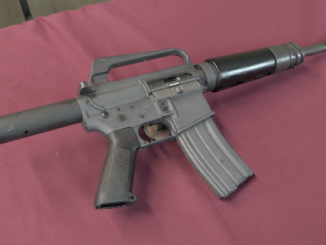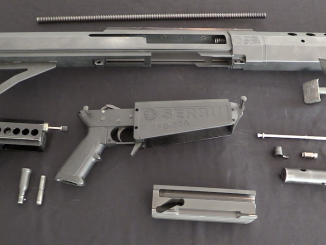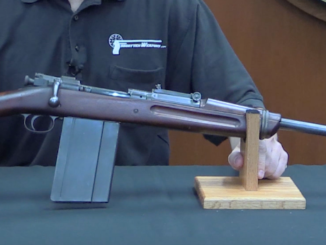Right at the beginning of the 20th century, there were 3 options on the market for semiauto commercial sporting rifles in the US: the Remington Model 8, the Winchester 1905/1907 Self-Loader, and the Standard Arms Model G. The Remington and Winchester were both good guns, and sold well – the Standard Arms was pretty much a flop, and has definitely become a forgotten weapon today. Its primary fault was durability – the rifles had a reputation for parts breakage, as the design wasn’t quite well enough thought out to handle to power of the rifle cartridges it was chambered for.
The Model G used a tilting bolt like the FAL and a long-stroke gas piston to cycle, and had the interesting option of allowing the shooter to disable the gas system and run the rifle as a pump action instead. It was available in the standard Remington autoloader cartridges, with .30 Remington seeming to have been the most common (and both of these examples are in .30). After the Model G was discontinued, an attempt was made to continue selling guns using the same parts by releasing the Model M, which was pump action only – but this failed to attract enough interest to keep the company afloat.
These two examples are available as a single lot from RIA on Friday, February 20th.




You probably know already, but you have that video set to private :/
I could imagine it being the basic basis, for the Browning automatic rifle.
John Browning already had the basis for the BAR mechanism in the M1895 Potato Digger. The difference is the Digger’s bolt drops to lock instead of rising.
Well it looks kind of similar…
“there were 3 options on the market for semiauto commercial sporting rifles in the US: the Remington Model 8, the Winchester 1905/1907 Self-Loader, and the Standard Arms Model G.”
Don’t forget about other, less popular rifles like Krnka semi-auto rifle: http://vintagesemiautorifle.proboards.com/thread/311/roth-krnka
Notice the price from 1903 catalog: $150.00 for rifle and $5.50 for box with 100 special cartridges. Remember that there are 1900s dollars (i.e. 16.00$ = 1 ounce of gold)
BTW: How many in 1910 cost: Remington Model 8, Winchester Model 1907 and Standard Arms Model G? I suspect that cartridge shouldn’t be substantially more expensive that other (for example .30 Remington Autoloading compared with .30-30 Winchester), but what with availability of this cartridges?
that is a nice piece of wood on that last one!
One point; I’ve always understood that the fancy pump-action grip and buttplate of the Model G and M were cast bronze, not brass.
As others have noted, the Model G’s mechanism is very similar to that of the BAR. The principle differences are that the BAR is hammer-fired rather than striker-fired, and it locks by a pivoting locking block attached to the bolt rather than pivoting the entire bolt’s rear end upward.
Rather than changing the rifle to a manual pump-action, it would have made more sense to thicken up that weak cross-pin, and add a buffer assembly in the stock as on the BAR to soften the recoil force by increasing the dwell time of the recoil/counter recoil stroke. Then “lose” the pump-action option entirely.
(I used to own a SPAS-12 with that sort of Heath Robinson setup. It drove me even crazier than the shotgun’s double safety system, which was a safety hazard on a tactical shotgun.)
Thanks for noting that the rifle was also available in .32 Remington. Most sources only list .25, .30, and .35 Remington as standard on the Model G.
I’d have to say that the Model G’s main problem was being a little ahead of its time. It needed better metallurgy than was available c.1910 to be reliable.
Unlike most self-loading rifles of its time, it was neither excessively complex (Mondragon gas-operated) or overly simplified (Mauser recoil-operated types). Given decent metals and some strengthening here and there, it might have made a decent infantry rifle, especially with a 10 or 15-shot detachable box magazine.
.30 Remington would have been the best choice for it in this role, as it was ballistically very close to the 7 x 57mm Mauser. .300 Savage would have been even better, as it was of course the basis for the later U.S. T65 round later better known as 7.62 x 51mm NATO aka .308 Winchester.
Keep in mind that in its own era, such a “product-improved” and militarized Model G wold have had the field almost all to itself, as unlike the post-World War 2 era there were very few automatic rifles available as surplus from the “Great War”. Mainly due to a lack of many actually being issued or even built during said “War To End All Wars”.
cheers
eon
Daweo
From”Alfa” catalogue 1911
Standard Model G cal25, 30, 35 240 mark
” Model M ” ” ” 199 mark
Winch M1907 cal 351 168 mark
Winch M1910 cal 401 180 mark
Browning Auto Rifle cal 9mm (FN made Rem M1908 35 cal)240 mark
Clement-Neumann cal 401 228 mark
4 Mark = $1 US
Thanks for posting that – very cool to see comparative prices!
The way the action breaks apart is neat looking, but would have been wasteful of steel and machining time.
For anyone wanting to restore the Japanned finish, this is something often done by collectors of old hand planes (e.g., Stanley hand planes have a black Japanned finish on them) and a web search can yield the instructions on how to do this.
I had a Model G in 30 Remington. It was both interesting and disappointing. It was fairly light compared to a Winchester self loader (also had one of those – awful is not strong enough for that one) and handled well. The end of the long gas piston threaded into a block that was attached to the two ‘action bars’ that were shown. It was a tapered thread about 1/4″ diameter and was pulled out of the block by the ridiculously stiff spring and mass of the piston. I have no doubt that they could have succeeded if the spring was lighter, the piston was lighter, and the threaded end of the piston was stronger. Otherwise it worked well once I got it fixed. Accuracy was decent but nothing special, about 2-3″ at 100 yards. The reason I got rid of it was that it was a brass mangler. It smashed the case mouths something awful.
Interestingly the Henry Ford Museum has one with a wooden forearm. It’s a deluxe model with checkering of the forearm.
Just a couple of corrections:
The bolt on the Standard Model G does NOT tilt to lock. It has a pivoting locking block that wraps around the top and sides of approx. 3/4 of the overall length of the bolt body.
If you know what to look for, it’s even visible in the video. Here are some bolt pictures (I hope linking like this works here):
http://i137.photobucket.com/albums/q201/Molasses_photos/Standard%20Model%20G/MVC-013F.jpg
(this next one is the best at showing the bolt/locking block relationship)
http://i137.photobucket.com/albums/q201/Molasses_photos/Standard%20Model%20G/MVC-014F.jpg
(this rear view shows the locking surface lifted above the bolt)
http://i137.photobucket.com/albums/q201/Molasses_photos/Standard%20Model%20G/MVC-015F.jpg
Additionally, I’ve picked up some reprints of Standard’s catalogs. Even their introductory “Advance Catalog A -1909 ” lists the pump-only Model M in it. In other words, the Model M was part of the lineup from the start, not introduced after the Model G had failed in the marketplace.
Well, now I feel dumb! Obviously, I didn’t take the bolt all the way out and never saw this. Thanks for the correction!
Did I see it right? The striker is compressed against the locked bolt at first, then the bolt unlocks and is catapulted backwards by the striker’s compression spring, then stopped apruptly by the pin that connects bolt and gas piston assembly? No wonder the gun experienced durability problems, this kind of setup puts a lot of wear on that spot..
We have an heirloom Standard arms Model M (have to confirm M or G) that has been passed down from my Great Grandpa. It is Chambered in 35 Remington. We hunt with it every year and out to 100-150yds we don’t have much that is more accurate. There is just something about hunting/using a family gun!